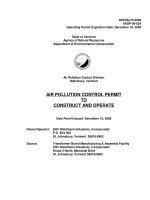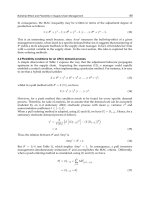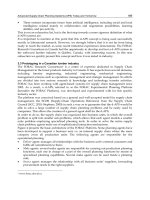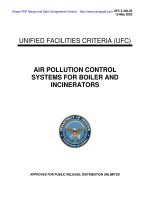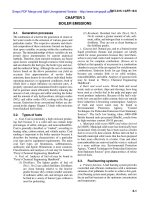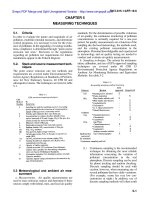Air Pollution Control Systems for Boiler and Incinerators Part 1 doc
Bạn đang xem bản rút gọn của tài liệu. Xem và tải ngay bản đầy đủ của tài liệu tại đây (133.2 KB, 10 trang )
UFC 3-430-03
15 May 2003
UNIFIED FACILITIES CRITERIA (UFC)
AIR POLLUTION CONTROL
SYSTEMS FOR BOILER AND
INCINERATORS
APPROVED FOR PUBLIC RELEASE; DISTRIBUTION UNLIMITED
UFC 3-430-03
15 May 2003
1
UNIFIED FACILITIES CRITERIA (UFC)
AIR POLLUTION CONTROL SYSTEMS FOR BOILER AND INCINERATORS
Any copyrighted material included in this UFC is identified at its point of use.
Use of the copyrighted material apart from this UFC must have the permission of the
copyright holder.
U.S. ARMY CORPS OF ENGINEERS (Preparing Activity)
NAVAL FACILITIES ENGINEERING COMMAND
AIR FORCE CIVIL ENGINEER SUPPORT AGENCY
Record of Changes (changes are indicated by \1\ /1/)
Change No. Date Location
This UFC supersedes TM 5-815-1, dated 9 May 1988. The format of this UFC does not conform to
UFC 1-300-01; however, the format will be adjusted to conform at the next revision. The body of
this UFC is a document of a different number.
ARMY TM 5-815-1
AIR FORCE AFR 19-6
AIR POLLUTION CONTROL SYSTEMS
FOR
BOILERS AND INCINERATORS
DEPARTMENTS OF THE ARMY AND THE AIR FORCE
MAY 1988
REPRODUCTION AUTHORIZATION/
RESTRICTIONS
This manual has been prepared by or for the Government and, except to the extent
indicated below, is public property and not subject to copyright.
Copyright material included in this manual has been used with the knowledge and
permission of the proprietors and is acknowledged as such at point of use. Anyone
wishing to make further use of any copyrighted materials, by itself and apart from
this text, should seek necessary permission directly from the proprietors.
Reprints or republications of this manual should include a credit substantially as
follows: :Joint Departments of the Army and Air Force, U.S., Technical Manual
TM 5-815-1/AFR 19-6, AIR POLLUTION CONTROL SYSTEMS FOR
BOILERS AND INCINERATORS."
If the reprint or republication includes a copyrighted material, the credit
should also state: "Anyone wishing to make further use of copyrighted
materials, by itself and apart from this text, should seek necessary
permission directly from the proprietors."
TM 5-815-1/AFR 19-6
1-1
CHAPTER 1
GENERAL
1-1. Purpose ject material relating to the topic of this manual can be
a. This manual is designed to facilitate the identifica-
tion of air pollutant emission rates, and the selection of
control equipment required to meet local, state, and
federal compliance levels. Presented herein are fuel
classifications, burning equipment types, emission rate
factors, emission measuring techniques, control equip- Military facilities have air pollution control problems
ment types, and control methods. Also included are which are unique to their mission. Among the
discussions of stack dispersion techniques, and control problems are those associated with classified waste
equipment selection. disposal, ammunition, plant wastes, chemical warfare
b. Each control equipment chapter provides per- wastes, hazardous toxic waste, and radioactive wastes.
formance data and equipment limitations which aid in Each will require a consultant or a specialist to help
the comparative selection of control equipment types. solve the unique problem. Therefore, each unique
Each chapter includes a discussion of the basic control problem will require special handling on a case-to-case
theory, various equipment types, collection efficiency, basis. The manual does not include any information on
pressure drop, operating requirements and limitations, treatment of emissions, or the incineration of these
application, materials of construction, and advantages unique materials.
and disadvantages in relation to other type control
equipment. 1-4. Economic considerations
1-2. Scope
a. This manual has been limited to the application of more types of design are known to be feasible must be
control equipment to fuel burning boilers and incin- based on the results of a life cycle cost analyses, pre-
erators for the purpose of reducing point-source emis- pared in accordance with the requirements of the
sion rates. A procedural schematic for its use is Department of Defense Construction Criteria Manual
illustrated in figure 1 - 1. Although the selection of a (DOD 4270. 1-M). Standards for the conduct of all
site, a fuel, and burning equipment are outside the economic studies by and for the Department of the
scope of this manual, there are alternatives available to Army and the Department of the Air Force are
the engineer in arriving at the least-cost solution to air contained in AR 11-28 and AFR 178-1, respectively.
pollutant problems. Once these factors have been Subject to guidance resulting from implementation of
decided, boiler or incineration emission rates and Executive Order 12003 and related guidance from
reduction requirements can be estimated using chap- DOD, the cited economic analysis techniques are to
ters 2 and 3. remain valid. The basic underlying principles and the
b. If emission rates are in compliance with local, most commonly used techniques of economic analysis
state, and federal regulations for point-sources, their are described in some detail in a variety of publications
effect on local air quality must yet be ascertained. Such and standard textbooks on engineering economy such
factors as stack height and prevailing meteorological as Principles of Engineering Economy by Grant,
conditions, while affecting ambient pollution levels, do Arisen, and Leavenworth; guides published by
not have an effect on point-source emission rates. They professional organizations such as the American
are considered in this manual only to make the reader Institute of Architects’ Life Cycle Cost Analysis-a
aware of their importance. These factors are unique for Guide for Architects; and handbooks prepared by
each particular site, and usually warrant expert con- government agencies such as the Naval Facilities
sultation. If emission rates for a boiler or incinerator Engineering Command's "Economic Analysis
are above local, state or federal requirements, or if air- Handbook”, NAVFAC P-442. Clarification of the basic
quality regulations might be violated, selection of a standards and guidelines for a particular application
pollution control device will be required. The technical and/or supplementary standards for guidelines which
and cost selection of control equipment are embodied may be required for special cases may be obtained by
in this manual. request through normal channels to Headquarters of
c. Appendix A contains a list of references used in the particular service branch involved.
this manual. A bibliography listing publications of sub-
found at the end of this manual. Also included is a
glossary listing abbreviations and a brief definition of
terminology used in the text.
1-3. Unique control problems
The selection of one particular type of design for a
mechanical system for a given application when two or
TM 5-815-1/AFR 19-6
1-2
TM 5-815-1/AFR 19-6
2-1
CHAPTER 2
INCINERATOR EMISSIONS
2-1. Incineration solid, semi-solid, liquid, or gaseous waste at specified
This chapter describes and quantifies whenever possi-
ble the air pollution particulate emissions which are the
direct result of the incineration process.
a. Incineration process. The incineration process
consists of burning solid, semisolid, liquid, or gaseous
waste to produce carbon dioxide, water, and ash. It is
an efficient means of reducing waste volume. The
solid, incombustible residue of incineration is inert,
sanitary, and sensibly odorless.
b. Emissions. Incineration contributes to air pollu-
tion. The polluting emissions are ash, hydrocarbons,
sulfur oxides (SO ), nitrous oxides (NO ), chlorides,
X X
and carbon monoxide. Estimating absolute quantities
of these pollutants is not an exact science, hut historical
testing data from typical incinerators allow estimates of
emissions to be made. Also, measurement methods for
incinerator emissions are sufficiently advanced to per-
mit actual data to be obtained for any existing incin-
erator. These measurements are preferred in all cases
over analytical estimates.
c. Pollution codes. Air pollution particulate emis-
sions must be considered in regard to federal, state and
local pollution codes. In general, incinerators cannot
meet current pollution code requirements without par-
ticulate control devices.
2-2. Types of incinerator waste materials
Waste materials are classified as shown in table 2-1.
An ultimate analysis of a typical general solid waste is
shown in table 2-2. Because of the wide variation in
composition of waste materials, an analysis of the
actual material to be incinerated should be made before
sizing incineration equipment.
2-3. Function of incinerators
Incinerators are engineered apparatus capable of with-
standing heat and are designed to effectively reduce
rates, so that the residues contain little or no combusti-
ble material. In order for an incinerator to meet these
specifications, the following principles of solid fuel
combustion generally apply:
— Air and fuel must be in the proper proportion,
— Air and fuel, especially combustible gases, must
be properly mixed,
— Temperatures must be high enough to ignite
both the solid fuel and the gaseous components,
— Furnace volumes must permit proper retention
time needed for complete combustion,
— Furnace configurations must maintain ignition
temperatures and minimize fly-ash entrainment.
2-4. Effect of waste properties
The variability of chemical and physical properties of
waste materials, such as ash content, moisture content,
volatility, burning rate, density, and heating value,
makes control of incineration difficult. All of these fac-
tors affect to some degree the operating variables of
flame-propagation rate, flame travel, combustion tem-
perature, combustion air requirements, and the need
for auxiliary heat. Maximum combustion efficiency is
maintained primarily through optimum incinerator
design.
2-5. Types of incinerators
a. Municipal incinerators. Incinerators are classified
either as large or small units, with the dividing point at
a processing rate of 50 tons of waste per day. The trend
is toward the use of the smaller units because of their
lower cost, their simplicity, and lower air emission
control requirements. There are three major types of
municipal incinerators.
(1) Rectangular incinerators. The most common
municipal incinerator is the rectangular type.
The multiple chamber units are either refrac-
tory lined or water cooled and consist of a
combustion chamber followed by a mixing
chamber. The multicell units consist of two
or more side-by-side furnace cells connected
to a common mixing chamber. Primary air is
fed under the grate. Secondary air is added in
the mixing chamber to complete combustion.
A settling chamber often follows the mixing
chamber. Ash is removed from pits in the
bottom of all of the chambers.
TM 5-815-1/AFR 19-6
2-2
(2) Vertical circular incinerators. Waste is usu-
ally fed into the top of the refractory lined
chamber. The grate consists of a rotating
cone in the center surrounded by a stationary
section with a dumping section around it.
Arms attached to the rotating cone agitate the
waste and move the ash to the outside.
Primary air is fed underneath the grate.
Overfire air is fed into the upper section of
the chamber.
(3) Rotary kiln incinerators. Rotary kiln incin-
erators are used to further the combustion of
waste that has been dried and partially
burned in a rectangular chamber. The waste
is mixed with combustion air by the tumbling
action of the kiln. Combustion is completed
in the mixing chamber following the kiln
where secondary air is added. The ash is
discharged at the end of the kiln.
b. Industrial and commercial incinerators. Indus-
trial and commercial incinerators generally fall into six
categories. The capacities of these incinerators gener-
ally range from a half to less than 50 tons per day. They
are usually operated intermittently.
(1) Single chamber incinerators. Single chamber
incinerators consist of a refractory lined com-
bustion chamber and an ash pit separated by
a grate. There is no separate mixing
TM 5-815-1/AFR 19-6
2-3
chamber. An auxiliary fuel burner is
normally provided underneath the grate. The
units are normally natural draft (no fans).
Emissions from single chamber units are high
because of incomplete combustion.
(2) Multiple chamber incinerators. Multiple
chamber refractory lined incinerators nor-
mally consist of a primary chamber, a mixing
chamber and a secondary combustion cham-
ber. The primary chamber is similar to a
single chamber unit. Air is fed under the
grate and through overfire air ports.
Secondary air is added in the mixing
chamber. Combustion is completed in the
secondary combustion chamber where some
settling occurs. These units are also normally
natural draft.
(3) Conical incinerators. Conical incinerators
known commonly as "tee-pee" burners have
been used primarily in the wood products
industry to dispose of wood waste. Since
they cannot meet most local particulate
emission requirements, and since wood
waste is becoming more valuable as a fuel,
conical incinerators are being phased out.
(4) Trench incinerators. Trench incinerators are
used for disposal of waste with a high heat
content and a low ash content. The
incinerator consists of a U-shaped chamber
with air nozzles along the rim. The nozzles
are directed to provide a curtain of air over
the pit and to provide air in the pit.
(5) Controlled-air incinerators. Controlled-air
incinerators consist of a refractory lined pri-
mary chamber where a reducing atmosphere
is maintained and a refractory lined
secondary chamber where an oxidizing
atmosphere is maintained. The carbon in the
waste burns and supplies the heat to release
the volatiles in the waste in the form of a
dense combustible smoke. Overfire air is
added between chambers. The smoke is
ignited in the secondary chamber with the
addition of air. Auxiliary fuel burners are
sometimes provided in the secondary
chamber if the mixture does not support
combustion. Air for this type of incinerator is
provided by a forced draft fan and is
controlled by dampers in order to provide the
proper distribution. Controlled-air
incinerators are efficient units with low
particulate emission rates.
(6) Fluidized bed incinerators. Fluidized bed
incinerators consist of a refractory lined ver-
tical cylinder with a grid in the lower part
that supports a bed of granular material, such
as sand or fine gravel. Air is blown into the
chamber below the grid causing the bed to
fluidize. Waste is fed above the bed and then
mixes with the media where it burns.
Fluidized bed incinerators are normally self
sustaining and require an auxiliary fuel
burner only for startup. Fluidizing air is
supplied by a centrifugal blower. Ash leaves
the fluidized bed incinerator when it becomes
fine enough to be carried out by the flue gas.
Fluidized bed incinerators are capable of
burning most types of liquid or solid waste.
c. Sludge incinerators. Sludge incinerators handle
materials high in water content and low in heat content.
Two types of incinerators are normally used for sludge
incineration.
(1) Multiple hearth incinerators. Multiple hearth
incinerators consist of vertically stacked
grates. The sludge enters the top where the
exiting flue gas is used to drive off the
moisture. The burning sludge moves through
the furnace to the lower hearths. Ash is
removed from under the last hearth.
(2) Fluidized bed incinerator. Fluidized bed
incinerators are particularly well suited for
sludge disposal because of the high heat
content of the bed media. Heat from the
combustion of the sludge is transferred to the
bed media. This heat is then transferred back
to the incoming sludge, driving off the
moisture.
2-6. Particulate emission standards
The Clean Air Act requires all states to issue regula-
tions regarding the amount of particulate emission
from incinerators. Each state must meet or exceed the
primary standards set forth by the federal act, limiting
particulate emissions for incinerators with a charging
rate of more than 50 tons per day of solid to .08 grains
per standard cubic foot (gr/std ft ) of dry gas at 12
3
percent carbon dioxide (CO ). Federal guidelines for
2
sewage sludge incinerators limit emissions to 1.3
pounds (lbs) per ton of dry sludge input and opacity to
20 percent maximum. No federal guidelines currently
exist for gaseous emissions. State and local regulations
may meet or exceed the federal guidelines. These reg-
ulations are subject to change and must be reviewed
prior to selecting any air pollution control device.
2-7. Particulate emission estimating
In order to select a proper pollution control device, the
quantities of particulate emissions from an incinerator
must be measured or estimated. Measurement is the
preferred method. For new incinerator installations
where particulate emissions must be estimated, tables
2-3 and 2-4 should be used unless concurrent data
guaranteed by a qualified Vendor is provided.
a. Factors affecting emission variability. The quan-
tity and size of particulate emissions leaving the fur-
nace of an incinerator vary widely, depending upon
TM 5-815-1/AFR 19-6
2-4

